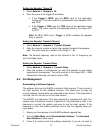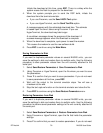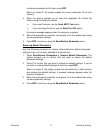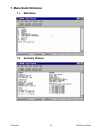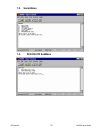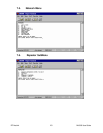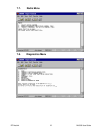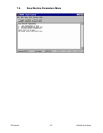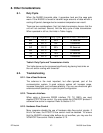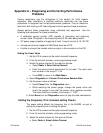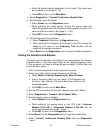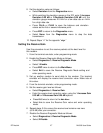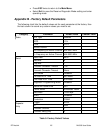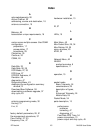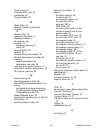RF Neulink
NL6000 User Guide
47
8. Set the deviation value as follows:
•
Select
Deviation
from the
Diagnostics
menu.
•
While watching the deviation gauge on the IFR, enter
1-Increase
Deviation 0.25 dB
or
2-Decrease Deviation 0.25 dB
until the
deviation gauge measures 2.5 kHz for a low data rate or 4 kHz
for a high data rate.
•
Press
Ctrl-A
or
Ctrl-B
to save the balance and deviation
values as the first or second reference point.
•
Press
ESC
to return to the
Diagnostics
menu.
•
Select
None
from the
Diagnostics
menu to stop the data
transmission.
10. Repeat Steps 1-7 for the opposite edge.
Setting the Receive Gain
Use this procedure to set the receive packets at the best level for
this modem.
1. From the terminal emulator, enter programming mode.
2. Enable the Receive Diagnostic Mode as follows:
•
Select
Diagnostics
ä
Receive Diagnostic Mode
.
•
Select
1-Enable
.
•
Press
ESC
twice to return to the
Main Menu
.
•
Select
Exit
to save the Receive Diagnostic Mode setting and
enter operating mode.
3. Set up another modem to send data to the modem. The terminal
emulator will display the receive level correction value. Make note of
this value.
4. From the terminal emulator, enter programming mode.
5. Set the receive gain level as follows:
•
Select
Diagnostics
ä
Receive Gain
.
•
Enter the receive level correction value, using the
1-Increase Gain
0.25 dB
or
2-Decrease Gain 0.25 dB
options.
•
Press
ESC
twice to return to the
Main Menu
.
•
Select
Exit
to save the Receive Gain value and enter operating
mode.
6. Repeat steps 3-5 to ensure the receive level remains near zero
(
±
0.5 dB) after your correction.
7. Disable the Receive Diagnostic Mode as follows:
•
Select
Diagnostics
ä
Receive Diagnostic Mode
.
•
Select
2-Disable
.



